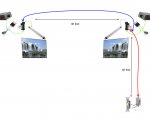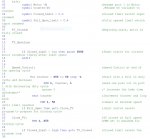joshzstuff
New Member
The project I'm working on is to open and close a set of TVs mounted on a hinge.
They are installed in a church stage, they fold against the wall when not in use and the actuators push them to face the audience when needed. (then pull back to the wall)
I didn't realize that I needed speed control, so I simply installed them controlled by a double pole relay with a reversing circuit. A single pole switch loop controls the actuators remotely.
The relays work fine, however the TVs, moving at full speed come to an abrupt stop, so I'd like to add a PWM circuit to slow them at the end of their extension.
Here is what my plan is:
I want to place a mosfet or some other driving circuit between the power supply and the relay. And control it with a micro controller (Pic/ Arduino)
I can program the speed control based on simply timing, or I can use a Potentiometer connected to the moving parts as a feedback.
I know that I could also replace the relays with H-bridge motor drivers, however if I can source the parts to augment the current setup it would seem simpler.
Specs and distances:
The actuator runs at 5 amps but peeks @ 8amps at startup.
https://www.amazon.com/gp/product/B017S3H05E/ref=oh_aui_detailpage_o06_s00?ie=UTF8&psc=1
I have 12 guage -2 conductor wire between the tv locations to send the switch positions simultaneously from the switch which is connected to the first TV location relay.
Can anyone recommend either discreet components for the motor driver, or else a board I can purchase to handle the load from the actuators?
I'm feel I should have something rated for 8-10 Amps.
Please let me know if I forgot to add any important details.
Thank You!
They are installed in a church stage, they fold against the wall when not in use and the actuators push them to face the audience when needed. (then pull back to the wall)
I didn't realize that I needed speed control, so I simply installed them controlled by a double pole relay with a reversing circuit. A single pole switch loop controls the actuators remotely.
The relays work fine, however the TVs, moving at full speed come to an abrupt stop, so I'd like to add a PWM circuit to slow them at the end of their extension.
Here is what my plan is:
I want to place a mosfet or some other driving circuit between the power supply and the relay. And control it with a micro controller (Pic/ Arduino)
I can program the speed control based on simply timing, or I can use a Potentiometer connected to the moving parts as a feedback.
I know that I could also replace the relays with H-bridge motor drivers, however if I can source the parts to augment the current setup it would seem simpler.
Specs and distances:
The actuator runs at 5 amps but peeks @ 8amps at startup.
https://www.amazon.com/gp/product/B017S3H05E/ref=oh_aui_detailpage_o06_s00?ie=UTF8&psc=1
I have 12 guage -2 conductor wire between the tv locations to send the switch positions simultaneously from the switch which is connected to the first TV location relay.
Can anyone recommend either discreet components for the motor driver, or else a board I can purchase to handle the load from the actuators?
I'm feel I should have something rated for 8-10 Amps.
Please let me know if I forgot to add any important details.
Thank You!
Last edited:


